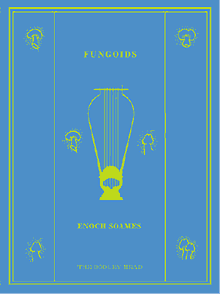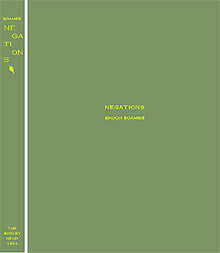|
A Letter to the Editor
From Carlos Alberto Cruz, C.
El Alba, Deep Patagonia.
27 May 1997.
Dear Sir,
This is to spiritually join in the originous
event that will be held in the Manuscript Saloon of the British Library
Galleries on June 3rd 1997 to commemorate the life of the poet Enoch
Soames. We are also sending you some notes to the paper: “An
Investigation into the History and Present Locations of the Fungoids”.
My notes, written in inexcusable Anglo-Patagonian, relate to a copy
of Soames’s Fungoids, which is now in my possession. Allow me to
relate the circumstances surrounding the Scott-McGuill-Kanwather copy
of Soames’s masterpiece.
During the late Victorian and Edwardian times
a number of English men settled in Patagonia: most of them were shepherds
who introduced the ovine cattle in the huge estancias (some of which
are several times larger than Belgium); there were also retired whale
sailors and a few adventurers who survived the hor- rible Southern Pole
Expeditions, a dire event which had not only taken their frozen arms
and hands, but, in some cases had even blinded their eyes and souls.
These uneven Britons were unable to be outdoors for five or seven months
each year, and therefore had to endure the largest, coldest, and most
windy winter in the world by reading voraciously. Patagonian landowners
had reputable booksellers who provided them with the latest books of
the first quarter of this century.
I have oft wandered from estancia to estancia,
which can sometimes be more than a hundred miles apart, and have bought
many books which are now of no use to their actual owners, who have
lost the English language of their forefathers, and which I still cling
on to, painfully aware of the Patagonian diction which infestates the
style of my prose.
Two years ago, in a shelf of Mrs. McGuill Kanwather,
a lady of mixed blood, half-English half-Fuegian, and perhaps related
to Jimmy Button or Fuegia Basket, the aborigines taken by FitzRoy and
Darwin to England in 1835, I found my copy of the Fungoids. This copy
was in the worst imaginable condition, watered all over and with its
pages, originally printed in a strange, greyish stock paper, close to
disintegration. The whole was practically unreadable, not to mention
the parts.
That day I had acquired from Mrs. McGuill Kanwather
a lot of pristine copies of Wilde. When I saw the copy of Fungoids I
thought it would not be difficult to get it for a small sum. Things
turned out quite differently. Mrs. McGuill Kanwather at first flatly
rejected to sell it. I had travelled five hundred miles, I was tired
and demanded an explanation. The lady simply said “this is not
a book, it is a relic.” I pressed her for a fuller explanation.
“All right,” she said, “this awful book was given to
me by my father as a token of esteem. Mr. McGuill helped recover Captain
R. F. Scott’s body and belongings after his awful death, in his
failed attempt to be the first man to reach the South Pole. You know
the story: when Scott arrived at his destination, he found a letter
written 33 days earlier by Amundsen, who beat everyone in the race to
reach the bottom of the globe.” Scott’s body and those of
Dr. E. A. Wilson and H. R. Bowers were recovered and buried eight months
after their sad defeat and frost-infested death in March 1912. Mr. McGuill
wanted to keep their Bible, but instead he received this poor book of
poetry in awful condition. Nevertheless he kept it with pride tinged
with some sadness for the fate of Captain Scott.
I made in haste a nervous and huge offer to
have the copy of the Fungoids, an irresistible offer that allowed me
to own the only surviving copy of Soames’s poems. My chest swelled
to the very brim with quiet pride. The copy bears a binding, half putrified
on the top, of the greyish awful paper with traces of humidity and polar
weather. But it was Soames’s masterpiece. What more could I seek?
A month ago the Enoch Soames
Society invited me to attend the centenary of the poet to be held in
the British Museum on June 3rd 1997. I was delighted, nay I was chuffed
to the very brim itself. I would be able to display my copy of the Fungoids
to all the followers and bibliophiles of the poet attending the celebration.
In late May I arrived in London with my book.
In preparation for this most important meeting
I visited my esteemed book dealer, he of the innocent face (like the
face of Mr. Bean) and bought an inscribed copy of Mr. Beerbohm’s
Seven Men and some topographical material relating to my native land.
I was also able to search an “archive” of undistinguished
but funny papers that I was not in search of. Relating to Soames, I
asked for material about Wilde’s Salomé, my favourite subject.
My distinguished bookseller was able to show me a fake manuscript of
Salomé that had been bought from a pseudo-Pierre Louÿs in
1921 for a huge sum of gold pounds. This manuscript was found later
to be a forgery, for “the paper on which part of the manuscript
was written had a Blandford Bond Strathmore watermark. The manufacturers
of this paper stated that this paper had not come on the market until
January 1915 (long after Wilde’s death),” says the report
given by an ancient partner of my bookseller’s firm.
I was very much interested in this phoney and
expensive case which had been enhanced by the recent discovery that
this pseudo-Pierre Louÿs who had made the forgery and took the
money was none other than the famous Dada activist, boxer, writer Arthur
Cravan. This happened after his “resurrection” from his shipwreck
off the coast of Mexico in which he, along with his Russian companion
Mr. Trotsky, was not thought to have survived. Cravan has been now absolved
of all guilt, and his forgeries recognised as poetical Dada boutades.
After the meeting with my bookseller, I ran
back, disturbed and nervous, to my little hotel near St. James’s
Place. Infested with trepidation I opened the small little safe in my
room where I keep the only remaining copy of the Fungoids. There it
was. I looked at the paper carefully to see its watermark with the interest
of the first man to peruse the Rosetta Stone. My worst fears were validated.
My copy of the Fungoids was printed on paper bearing the Blandford Bond
Strathmore watermark, the same used in the fake Salomé and which
had come on the market, alas in 1915, three years after Captain Scott
had been found dead in the South Pole of our globe. Questions, thousands
of questions.
I left London and came back to Patagonia. Sad
and ashamed, I renamed my copy the Cravan-Scott copy. I will not show
it to anybody, but it will stand for ever on my side table as a skull,
my own personal Vanitas.
Very respectfully yours,
Carlos Alberto Cruz C.
Notes
[1] See Hinda Rose.
[2] The forged Wilde manuscripts referred to by Sr.
Cruz are in the possession of the London bookselling firm of Maggs Bros.
Ltd. They relate to the extraordinary and successful forgery in 1921
of many Oscar Wilde manuscripts by a man passing himself oÏ as Pierre
Lou s, friend of Wilde and dedicatee of the French edition of Salome.
This man, who at some time sailed under the name of “Sebastian Hope”
is believed by some to have been the great proto-Dadaist and boxer Arthur
Cravan, whose supposed death at sea in the Gulf of Mexico was never
accepted by his friends and family. The forgery was in the end unmasked
by identifying the paper used as a type not manufactured until 1915.
Ed.
|




